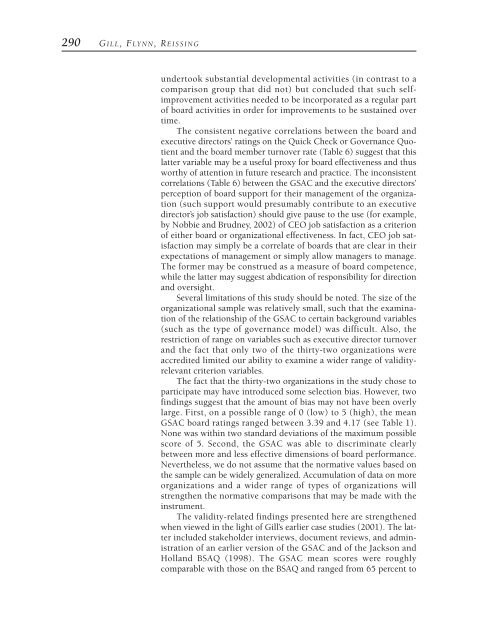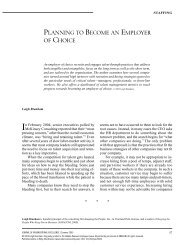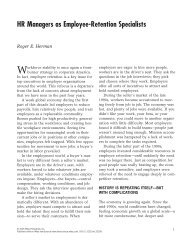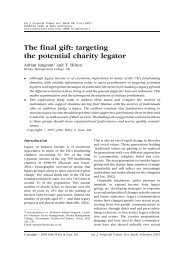The governance self-assessment checklist: An instrument for ...
The governance self-assessment checklist: An instrument for ...
The governance self-assessment checklist: An instrument for ...
You also want an ePaper? Increase the reach of your titles
YUMPU automatically turns print PDFs into web optimized ePapers that Google loves.
290 G ILL, FLYNN, REISSINGundertook substantial developmental activities (in contrast to acomparison group that did not) but concluded that such <strong>self</strong>improvementactivities needed to be incorporated as a regular partof board activities in order <strong>for</strong> improvements to be sustained overtime.<strong>The</strong> consistent negative correlations between the board andexecutive directors’ ratings on the Quick Check or Governance Quotientand the board member turnover rate (Table 6) suggest that thislatter variable may be a useful proxy <strong>for</strong> board effectiveness and thusworthy of attention in future research and practice. <strong>The</strong> inconsistentcorrelations (Table 6) between the GSAC and the executive directors’perception of board support <strong>for</strong> their management of the organization(such support would presumably contribute to an executivedirector’s job satisfaction) should give pause to the use (<strong>for</strong> example,by Nobbie and Brudney, 2002) of CEO job satisfaction as a criterionof either board or organizational effectiveness. In fact, CEO job satisfactionmay simply be a correlate of boards that are clear in theirexpectations of management or simply allow managers to manage.<strong>The</strong> <strong>for</strong>mer may be construed as a measure of board competence,while the latter may suggest abdication of responsibility <strong>for</strong> directionand oversight.Several limitations of this study should be noted. <strong>The</strong> size of theorganizational sample was relatively small, such that the examinationof the relationship of the GSAC to certain background variables(such as the type of <strong>governance</strong> model) was difficult. Also, therestriction of range on variables such as executive director turnoverand the fact that only two of the thirty-two organizations wereaccredited limited our ability to examine a wider range of validityrelevantcriterion variables.<strong>The</strong> fact that the thirty-two organizations in the study chose toparticipate may have introduced some selection bias. However, twofindings suggest that the amount of bias may not have been overlylarge. First, on a possible range of 0 (low) to 5 (high), the meanGSAC board ratings ranged between 3.39 and 4.17 (see Table 1).None was within two standard deviations of the maximum possiblescore of 5. Second, the GSAC was able to discriminate clearlybetween more and less effective dimensions of board per<strong>for</strong>mance.Nevertheless, we do not assume that the normative values based onthe sample can be widely generalized. Accumulation of data on moreorganizations and a wider range of types of organizations willstrengthen the normative comparisons that may be made with the<strong>instrument</strong>.<strong>The</strong> validity-related findings presented here are strengthenedwhen viewed in the light of Gill’s earlier case studies (2001). <strong>The</strong> latterincluded stakeholder interviews, document reviews, and administrationof an earlier version of the GSAC and of the Jackson andHolland BSAQ (1998). <strong>The</strong> GSAC mean scores were roughlycomparable with those on the BSAQ and ranged from 65 percent to







